Fasciculus Medicinae
Fasciculus Medicinae is the name of a medical text collection created in 1450, richly illustrated and printed in Venice in 1491. The compiler of this collection is unknown. It was wrongly attributed to the doctor Johann de Ketham (died 1470).
The work is one of the first medical textbooks with subject-related illustrations. Since the mid-19th century, the Fasciculus Medicinae has received increased attention in the context of research into the history of anatomy. The differences in the anatomical depictions of women in the 1491 and 1493 editions were interpreted as an "abrupt transition from the scholasticist illustration to a realistic depiction that is completely adequate to our present-day perspective" . (Herrlinger 1967, p. 69)
swell
The sources of three treatises in the collection are given in the text:
- Petrus de Tossignano (1376-1407). Consilium pro peste evitanda. (Advice on how to protect yourself from the plague.) Dedicated to Giovanni Galeazzo Visconti .
- Included in the "Fasciculus Medicinae" since the first (Latin) edition in 1491.
- Lucius Mundinus ( ca.1270-1326 ). Anatomia. (Anatomy.) A collection of practical dissection exercises first published in 1316.
- Included in the “Fasciculus Medicinae” only from the (Italian) edition 1493 onwards.
- Rhazes (around 864-925). De aegritudinibus puerorum. (About children's diseases).
- Included in the “Fasciculus Medicinae” only from the (Latin) edition February 17, 1500.
The section on bloodletting is identical to a Latin text that is first accessible in a manuscript written between 1450 and 1470 in southern Germany ( Cpg 644 ). In 1517 Hans von Gersdorff translated essential parts of this bloodletting treatise into German.
The sources for most of the papers in the collection have not yet been determined. The author of the so-called three-picture series (“Illness Woman and Illness Man” based on Czech text and “Wound Man” with accompanying text from the work of Ortolf von Baierland ) may come from Prague.
Incunabula and early prints
- Latin.
- Giovanni and Gregorio de Gregoriis (eds.): Fasciculus Medicinae. Venice. a) July 26, 1491, b) October 15, 1495, c) February 17, 1500, d) March 28, 1500, e) 1508 and f) February 10, 1513
- Claus de Grave, Antwerp 1512
- C. Arrivabenum, Venice 1522
- Italian.
- Giovanni and Gregorio de Gregoriis, Venice February 5, 1493
- J. de Castelliono, Mediolani 1509
- C. Arrivabenum, Venice 1522
- Giov. Ant.Vidali, Venice 1688
- Spanish.
- P. Huros, Saragossa. Compendio de la salud humana. August 15, 1494
- J. Burgos, Burgos. Epilogo in medicina. May 15, 1495
- Guillen, Pamplona. Epilogo in medicina. October 10, 1495
- J. Cromberger, Seville 1517
- Dutch
- Claes de Grave, Amsterdam 1512
Images and texts in editions 1491, 1493 and 1500
| Illustrations | Edition 1491 Latin | Edition 1493 Italian | Edition 1500 Latin |
|---|---|---|---|
| cover photo | The cover picture was missing in the 1491 edition | 1r 
|
1r 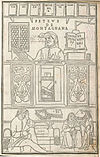
|
| "Medical instruction" | The pictured as contour woodcut uroscopy scene was missing in the first edition of 1491 | 1v 
|
1v 
|
| Uroscopy board | 1v 
|
2r 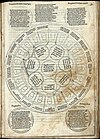
|
2r 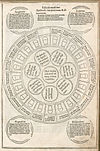
|
| 2r “De expositione colorum in vrinis: Deinde de eorum indiciis. Vrina est colamentum sanguis ... "(" Explanation of the urine colors and what they mean. The urine is that which is sifted out of the blood. ... ") | 2v-3v “Prima la exposure del color delle Vrine e iudicio de quelle. Vrina e colamento di sangue ... " | 2v-3r “De expositione colorum in vrinis: Deinde de eorundem iudiciis. Vrina est colamentum sanguinis ... " | |
| The Latin bloodletting texts in the Fasciculus Medicinae are first accessible in a manuscript written between 1450 and 1470 in southern Germany ( Cpg 644 ). Based on this Latin text, Hans von Gersdorff made a German translation for his "Feldbuch der Wundarznei" (Chapters 13-16) in 1517. | |||
| Bloodletting man | 2v 
|
8v 
|
3v 
|
| 3r Description of the location and indications of 29 bloodletting sites | 9r-9v Description of the location and indications of 29 bloodletting sites | 4r Description of the location and indications of 29 bloodletting sites | |
| 3v-4v "De iudiciis venarum et de minutionibus eandarum vna cum cautelis. Minutio alia per metatasim alia per antifrasim et si sit inveterata passio fiat minutio per metatasim. ... "(" About the assessment of the veins and the emptying of the same and which precautionary measures must be taken. The emptying takes place either on the side of the disease or on the side opposite the disease. Chronic diseases are treated by acting on the diseased side . ... ") | 9v-12r “Questa tavla tracta deli iudicii dele uene & della diminution di quelle insieme con le cautele: Minution de sangue alcuna per drita uia: alcuna per contrario si fa se la passione sara iuecchiata facciasi la minutione dallato dele passione. ... " | 4v-6r “De iudiciis venarum et de minutionibus eandarum vna cum cautelis. Minutio alia per metatasim: alia per antifrasi. Et si sit inueterata passio fiat minutio per metatasim. ... " | |
| Bloodletting man with zodiac signs | 5v 
|
8r 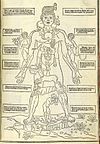
|
6v 
|
| "Sick woman" | 5v 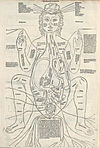
|
19r 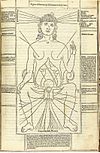
|
7r 
|
| 6r-6v "Quando mulier dolet ubera ..." ("If a woman has chest pain ...") | 19v-21r "Quando la donnan patise dolor de poppe ..." | 7v-8r "Quando mulier dolet ubera ..." | |
| 7r-8v "Problemata de membris generationis de matrice: et testiculis seu de secretis mulierum ..." ("Symptoms of the reproductive organs uterus and testicles or about the secrets of women. ...") | 21r-25v "Seguitanole poblema ouero interrogationi delli membri genitali cio e de la matrice & testiculi ouero secreti della donna ..." | 8v-10v "Problemata de membris generationis de matrice: et testiculis seu de secretis mulierum ..." | |
| Wound man | 9r 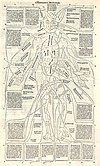
|
12v 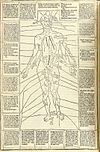
|
11r 
|
| 9v-10r Surgical antidotarium with reference to the illustration of the wounded man 10v-11v prescriptions | 13r-18v Surgical antidotarium with reference to the illustration of the wounded man | 11v-13v Surgical antidotarium ... | |
| "Sick man" | 12r
|
4r 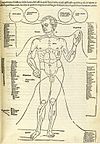
|
14r 
|
| 12v-13v Disease register in alphabetical order | 4v-7v Alphabetically sorted disease register | 14v-16r Illness register in alphabetical order | |
| Room with plague sufferer | The illustration of the room with the plague was missing in the 1491 edition | 26r 
|
16v 
|
| 14r-15v Petrus de Tossignano. "Consilium pro peste evitanda." ("Advice on how to protect yourself from the plague.") | 26v-32r "Cosiglio per la peste composto dal famosissimo doctor delle arti & medicina Maestro Pieri Tausignano ..." | 17r-20r Petrus de Tossignano. “Consilium pro peste evitanda. ... " | |
| Corpse opening | The illustration of the opening of the corpse was missing in the 1491 edition | 26v 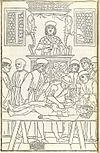
|
20v 
|
| 27r-45v Mondino dei Luzzi. "Anatomia." | 21r-30v Mondino dei Luzzi. "Anatomia." | ||
| 31r-32r Rhazes. "De egritudines puerorum." ("On diseases of children.") | |||
| 26r and 46 r A treatise on 10 herbs with the title: "Proprieta de herbe provade & e verissima." |
literature
-
Ludwig Choulant .
- History and bibliography of anatomical mapping as it relates to anatomical science and the visual arts. Rudolph Weigel, Leipzig 1852. p. 4: Mondino the Luzzi. Pp. 18-22: Johannes de Ketham.
- History and bibliography of anatomic illustration in its relation to anatomic science and the graphic arts. Translated and edited with notes and a bibliography. By Mortimer Frank. With a biographical sketch of the translator and two additional sections by Fielding H. Garrison and Edward Clark Streeter. Univ. of Chicago press, Chicago 1920. pp. 88-96: Mondino de Luzzi. Pp. 115-122: Johannes de Ketham
-
Karl Sudhoff .
- The "Wound Man" in early print and handwriting and its explanatory text. A contribution to the history of the sources of "Ketham". In: Archives for the History of Medicine. I (1907), pp. 351–361 (digitized version )
- The Fasciculus Medicinae by Johann de Ketham Alemannus. (= Monumenta medica. Volume 1, edited by Henry E. Sigerist ). Lier, Milan 1923, pp. 38–57: Historical introduction
- Robert Herrlinger . History of medical imaging from antiquity to around 1600. Heinz Moos, Munich 1967.
- Gundolf Keil : 'Wound Man'. In: Werner E. Gerabek , Bernhard D. Haage, Gundolf Keil, Wolfgang Wegner (eds.): Enzyklopädie Medizingeschichte. De Gruyter, Berlin / New York 2005, ISBN 3-11-015714-4 , p. 1504 (on the three-image series: sick man, pregnant sick woman and wound man).
- Michel Thiery: Gynaecologie en verloskunde in de Middelnederlandse vertaling van de Fasciculus medicine uit 1512. In: Geneeskunde in nederlandstalige teksten tot 1600. Koninklijke Academie voor Geneeskunde van België, Brussels 2012 (2013), ISBN 978-90-75273-29-8 , Pp. 139-167.
Web links
- Ludwig Choulant . History and bibliography of anatomical illustration… Leipzig 1852. P. 4: Mondino dei Luzzi (digitized version ) . Pp. 18–22: Johannes de Ketham (digitized version ) .
- Ludwig Choulant , Mortimer Frank… History and bibliography of anatomic illustration… Chicago 1920. pp. 88–96: Mondino de Luzzi (digitized version ) . Pp. 115–122: Johannes de Ketham (digitized version )
- Fasciculus medicinae. Linked to it: Petrus <de Tussignano> (Pietro da Tussignano, around 1335 to 1407): Consilium pro peste evitanda. Dedicated to Giovanni Galeazzo Visconti. - Mundinus: Anatomia. - Rhazes, Muhammad: De aegritudinibus puerorum. <Latin.> Translated from Arabic (?) (digitized version)
Individual evidence
- ↑ Gundolf Keil: "I, master Ortolf, born from Beierlant, a doctor in Wirzeburc". On the history of Würzburg medicine in the 13th century. In: Annual report of the Julius Maximilians University of Würzburg on the academic year 1975/76. Würzburg 1977 (= Würzburger Universitätsreden, 56), pp. 17–42; here: p. 33
- ↑ Julius Pagel . John de Ketham. In: August Hirsch (Ed.). Biographical lexicon of the outstanding doctors of all times and peoples. Urban & Schwarzenberg, Vienna Volume III 1886, p. 465 (digitized version)
- ↑ Consilium pro peste evitanda . Print Venice approx. 1472 (digital copy )
- ^ Arnold Carl Klebs . The first printed plague pamphlets. Historical and bibliographical research. Verlag der Münchner Drucke, Munich 1926, pp. 110–113
- ^ Antonio de Carcano, Pavia 1478 (digitized version) . Bologna 1482. Anathomia Mundini. (Digitized version) . Martin Landsberg, Leipzig approx. 1493. Anathomia Mundini. (Digitized version) . Locatellus, Venice 1507. Anathomia Mondini. (Digitized version) . Bononia 1514. De omnibus humani corporis interioribus membris Anatomia. (Digitized version)
- ↑ Liber Rasis ad almansorum. Pentium de Leucho, Venice 1508, sheet 89r-90r (digital copy )
- ^ Cpg 644. Medical tracts and prescriptions . Southern Germany 1450 - 1470, sheet 63-76r (digital copy )
- ↑ Hans von Gersdorff. Field book of wound medicine . Schott, Strasbourg 1517, sheet 14r-18r (chapters 13-16) (digitized version)
- ↑ Friedrich Lenhardt: “When ain man willingly let go”. Instructions for the therapy of complications in bloodletting. In: “gelêrter der arzeniê, ouch apotêker”. Contributions to the history of science. Festschrift for the 70th birthday of Willem F. Daems. Edited by Gundolf Keil, Horst Wellm Verlag, Pattensen / Hannover 1982 (= Würzburg medical-historical research, 24), ISBN 3-921456-35-5 , pp. 269-300, here: pp. 280-281
- ↑ Erltraut Auer, Bernhard Schnell : The 'wound man'. A traumatological scheme in the tradition of Ortolf von Baierland's 'wound medicine'. In: Gundolf Keil, Johannes G. Mayer, Christian Naser (eds.): "Make a teutsch puech". Investigations on the local language mediation of medical knowledge (= Ortolf studies , 1), Reichert, Wiesbaden 1993 (= knowledge literature in the Middle Ages. Writings of the Collaborative Research Center 226 Würzburg / Eichstätt. Volume 11), ISBN 3-88226-539-6 , p. 349– 401
- ↑ Gundolf Keil: 'Wundenmann'. 2005, p. 1504.
- ↑ Fasciculus Medicinae . Gregoriis, Venice July 26th 1491. (digitized version )
- ↑ Fasciculus Medicinae . Gregoriis, Venice 17th February 1500. (digitized version)
- ↑ Fasciculus Medicinae. Gregoriis, Venice February 5, 1493 (digitized version)
- ↑ Johannes de Ketham [sic!]: Fasciculus Medicinae. Edited by Sabastiono Manilio Romano, Venice 1493 (Da Giovanni e Gregorio dé Gregori copia acquarellata conservata presso la Civica Bibliotheca di Bergamo incunabulo P 3 10); Reprint (Grafica Gutenberg) Gorle / Bergamo 1976 (= Monumenta Longobardica , VIII).
- ^ According to Klebs (1938, p. 192) the following treatises were added to the Spanish editions: 1.) Anonymous. Generacion de la criatura. 2.) Michael Scotus . Physiognomia. ( Printed in Venice 1477 ) 3.) Valasco de Tarenta. De epidemia et peste. (span.)
- ↑ Fasciculus Medicinae, Amsterdam 1512 (digital copy)
- ↑ Ludwig Choulant and Mortimer Frank. History and bibliography of anatomic illustration in its relation to anatomic science and the graphic arts. Translated and edited with notes and a bibliography. By Mortimer Frank. With a biographical sketch of the translator and two additional sections by Fielding H. Garrison and Edward Clark Streeter. Univ. of Chicago press, Chicago 1920. pp. 88-96: Mondino de Luzzi. (Digitized version) . Pp. 115–122: Johann de Ketham (digitized version )
- ^ Arnold C. Klebs . Incunabula scientifica et medica. Bruges 1938 (reprint Olms, Hildesheim 2004), p. 192. There also a description of the different compositions of the individual editions.
- ↑ Friedrich v. Zglinicki : Uroscopy in the fine arts. An art and medical historical study of the urine examination. Ernst Giebeler, Darmstadt 1982, ISBN 3-921956-24-2 , p. 73 f. and 76.
- ^ Edition 1491 Latin, sheet 2r (digitized version )
- ^ Edition 1500 Latin, pages 2v-3r (digitized version )
- ↑ Friedrich Lenhardt: “When ain man willingly let go”. Instructions for the therapy of complications in bloodletting. In: “gelêrter der arzeniê, ouch apotêker”. Contributions to the history of science. Festschrift for the 70th birthday of Willem F. Daems. Edited by Gundolf Keil, Horst Wellm Verlag, Pattensen / Hannover 1982 (= Würzburg medical-historical research, 24), ISBN 3-921456-35-5 , pp. 269-300, here: pp. 280-281
- ^ Cpg 644. Medical tracts and prescriptions . Southern Germany 1450-1470 (digitized version )
- ↑ Hans von Gersdorff. Field book of wound medicine . Schott, Strasbourg 1517, sheet 14v-18r (digitized version )
- ^ Edition 1491 Latin, sheet 3r (digitized version )
- ^ Edition 1491 Latin, sheet 4r (digitized version )
- ^ Edition 1491 Latin, pages 3v-4v (digitized version )
- ^ Edition 1500 Latin, pages 4v-6r (digitized version )
- ^ Edition 1491 Latin, pages 6r-6v (digitized version )
- ^ Edition 1500 Latin, pages 7v-8r (digitized version )
- ↑ Edition 1491 Latin, pages 7r-8v (digitized version )
- ↑ AD [istoph] Ferckel: For gynecology and intergenerational teaching in the fasciculus medicinae of Johannes de Ketham. In: Archives for the History of Medicine . Volume 6, Issue 3 (September) 1912, pp. 205-222.
- ↑ Henry E. Sigerist . A German translation of Ketham's gynecology. In: Archives for the History of Medicine. Volume 14, Issue 5/6, (December) 1923, pp. 169-178.
- ^ Edition 1500 Latin, sheets 8v-10v (digitized version )
- ^ Edition 1491 Latin, pages 9v-10r (digitized version )
- ↑ Edition 1491 Latin, pages 10v-11v (digitized version )
- ^ Edition 1500 Latin, sheets 11v-13v (digitized version )
- ↑ Edition 1491 Latin, pages 12v-13v (digitized version )
- ^ Edition 1500 Latin, pages 14v-16r (digitized version )
- ^ Edition 1491 Latin, pages 14r-15v (digitized version )
- ^ Edition 1491 Latin, pages 17r-20r (digitized version )
- ^ Edition 1500 Latin, sheet 27r-45v (digitized version )
- ↑ Edition 1500 Latin, sheets 31r-32r (digitized version )

